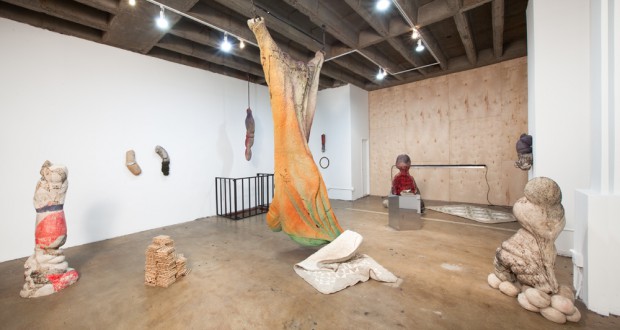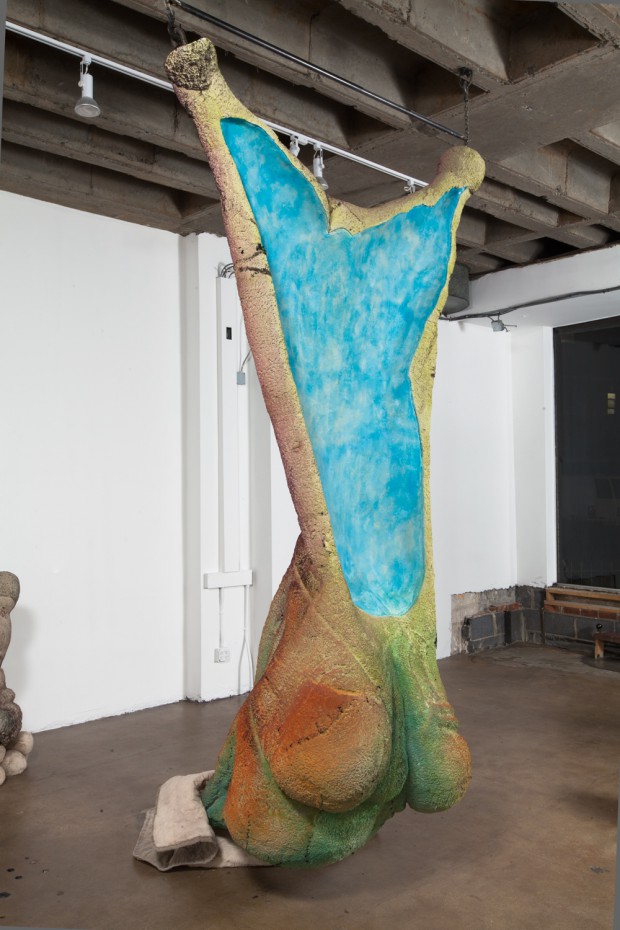Life is a shit hole to be laughed at. So goes the M.O. I imagine for Gavin Kenyon, who, in his latest show at Ramiken Crucible, departs from his painstakingly modeled, homicidal axes, to engage in process-based work. The result is a dynamic and visceral show that draws attention to Kenyon’s caustic, dry wit and his ability to create a sense of bleak isolation.
Visitors will immediately notice a plaster “beef carcass” hanging in the middle of the gallery. Stained a garish orange and synthetic green, its bold, attention-seeking palette stands apart from the predominant earth tones, creams, and reds found in the rest of the show. Kenyon made the sculpture by filling fur-lined bags with plaster and binding them with ropes, and then removing the bags from the form. Whatever fur is left, then sticks to the plaster. This technique creates an organic texture that could not be modeled.
This works out well for the artist; letting go of the artist’s hand and allowing the forces of chance and accident to dictate the aesthetic of the surface lends a refreshing freedom to the work. Most of the sculptures have been made utilizing the same process-based approach.
The sheer magnitude as well as the dominant placement of this animal places it in the leading role, with all other works becoming supporting cast members. Despite its heroic scale and loud coloring, it retains a sense of humility in its doleful, quiet, funereal quality.
Kenyon’s hanging carcass follows a long, established history; Rembrandt, Soutine, and Bacon are just a few artists who have famously tackled this subject. Yet Kenyon sexualizes the piece in a way that none of the other artists have by using the obvious metaphor of meat as phallus. On the other side of the meat hangs its monumental, but lifeless scrotum. The effect of the exaggerated scale also has a feeling of droll mockery; to blow up the gonads to such a preposterously gargantuan size and to rob them of their utility becomes an absurdist gesture. Continuing in this vein, a small quilt tenderly covers the bottom of the cadaver, in an attempt to comfort and acknowledge the dead animal. The quilt, which is comprised of cut canvases of found paintings, is a asynchronous nod to 60s and 70s Feminist art, and creates a needed contrast and balance to the overt masculine symbolism.
Situated towards the back end of the gallery stands a plaster bust on a mirrored pedestal. The sculpture represents the classic idea of what a bust should be, only it looks like a dog took a hunk out of its bloody, mauled posterior. With the piece’s traditional figuration and the reflective surface, it becomes easier to project ideas of the self. The act of looking in the mirror has often been interpreted as an act of self-affirmation and a comforting denial of death; no such luck here.
Even if we at first cannot identify with the the bust’s senseless, yet absurdly generic slasher film death, as soon as we look at the mirrored surfaces it rests on and see our own reflection, a passing awareness of memento mori sweeps over us. The feeling goes away, since the impenetrable dark humor operating here won’t allow any grave ruminations to persist. The excessively generalized brutality also self-consciously prevents any empathy to be felt towards the figure, that resembles more of a dummy than a human being.
Directly behind the bust, situated near the back wall, an armless “female” faces the ground with her ass up and her legs splayed apart, in a pose that can be interpreted as “ready and willing.” The figure reveals an awkward vulnerability despite being so sexually charged; she’s precariously positioned with no means of defending herself. Yet in the comical, clunky stylization she resembles less a victim than a satirical depiction of a sexual libertine relishing in the painful pleasures of BDSM. Both in its tawdry, discomfiting sexuality and its restrained, black-and-white monochromatic palette, the sculpture channels the repellent energies of one of Hans Bellmer’s sex dolls.
The ghost of Bellmer seems to also be present a few feet away from her, in the other hanging sculpture near the left wall, behind the carcass and over the stairwell. The piece, despite resembling mold-covered feces, has a soft and gentle quality. The use of scatological imagery in art often attempts to break taboo or be subversive, but typically fails to accomplish this, since in the art milieu we’ve seen a lot of shit. Here, Kenyon’s sculpture does not attempt to shock or challenge anything or anyone; instead it takes on the nonchalant attitude of being just another natural phenomenon.
A sense of isolation dominates the entire exhibition. In spite of the theatrical installation and the anthropomorphized pieces, none of the sculptures seems to be interacting with one another. By consequence each piece appears locked in time, bitterly and terribly alone.






{ 1 comment }
wow gorgeous!
Comments on this entry are closed.